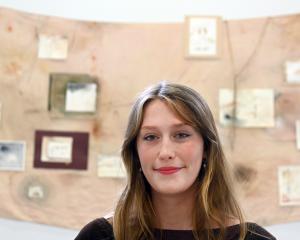
''Still'' (Milford Galleries)
''Still'', the latest exhibition at Milford Galleries, presents a symbiosis of artworks by three masters of different media, united by their austere and haunting monochromatic palette.
The best-known of the three artists is Christine Webster, master photographer, who provides several bleak yet tranquil landscapes, all of which reflect well the title of the exhibition.
The majority of the pieces, such as the impressive Therapies 4, feature panoramic wide-angle landscapes across emptiness to a distant horizon, in two of which the viewer is represented by a figure in the foreground.
Also well known is ceramicist John Parker, who presents several ''stage sets'', in which his slightly enigmatic pure white and black vessels stand alongside each other.
Line and form of these pieces is sumptuous, and when clustered in groups such as in this display, they take on a life of their own as actors in a play or chess pieces awaiting the start of a game.
The final artist may be less recognisable a name than his co-exhibitors, but Eliot Coates proves himself up to the challenge with several ethereal implied landscapes.
The works are in oil on aluminium, and, as with Webster's photographs, suggest a depth of empty land, with a distant horizon visible as if through mist.

''Intersections: Ceramics from Ralph Hotere's Personal Collection'' (Otago Museum)
Ralph Hotere was not only an artist of the highest order, but was also a collector of ceramics made by his contemporaries and friends in the New Zealand art scene.
''Intersections'' explores this side of Hotere, and sheds light on his relationship with his peers.
Works by long-time friend Barry Brickell form the heart of the exhibition, ranging from a large cracked amphora to intimate domestic ware.
One of these latter pieces bears the inscription ''E Hoa'' (Dear friend), which would be an ideal subtitle for the exhibition, for it is friendship as much as art which is being celebrated.
Hotere certainly had an eye for lovely work, whether in the joyous decoration of simple bottle forms or more substantial pieces such as Lawrence Ewing's storage crock.
Many show flashes of shared humour, such as the title of Brickell's ceramic Ralph's Plastic Plate Mihi.
Few of the pieces are specifically decorative only, the most notable of these being a small, attractive figurine by Ann Verdcourt.
The exhibition is topped off by a memorial post created to commemorate Hotere's father, which now also serves as a memorial to the artist himself.
As always with Otago Museum exhibitions, this display is excellently curated, with works annotated and arrayed attractively in miniature domestic settings.

''Local Supercluster'', Michael Harrison (Brett McDowell Gallery)
In his catalogue notes for Michael Harrison's 2002 exhibition ''Love in the Shadows'', Justin Paton talked of the artist as a ''poet of proximity'' whose ''strange, pale art'' was of things ''almost legible, almost remembered''.
The same terms aptly apply to Harrison's current exhibition.
Though using acrylic and pencil, Harrison's work has the diaphanous quality of watercolour, its haunting and haunted subjects inviting us into a world of half-formed symbol where dreams of images float in the frame, tantalising us with their never-substantial possibilities.
The works are built up slowly and thoughtfully, often over a process of years, as the artist makes repeated amendments to his original ideas.
Harrison uses a personal symbolic language in these works, a language of distracted nudes, floating birds, and inscrutable cats, which turns the pictures into tarotesque clue-laden riddles.
The artist is only too well aware of this, poking a sly jest at the viewer with the exhibition's opener, Teaser, with its jigsaw-puzzle motif under a smoky black sky.
Even the most naturalistic of the scenes, Coromandel, depicts an unearthly, prelapsarian dream forest.
The works remain tantalisingly real yet unreal, as though the artist has painted the emotional element of real scenes while somehow avoiding painting their tangible ''real'' nature.












